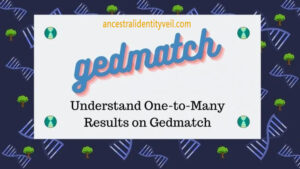In this article, I will help you learn to interpret One-to-Many results on Gedmatch. Eventually, you should feel comfortable reading your results.
Gedmatch provides many useful DNA analysis tools, but one of its most helpful is One-to-Many analysis. However, for new users it may seem overwhelming attempting to interpret such an expansive spreadsheet-type list of information and know exactly what it can tell them.

Gedmatch is not a DNA testing company; in order to access One-to-Many results on our site and gain access to them, you’ll need to undergo an Autosomal DNA Test or similar. Learn about them here: What Is an Autosomal DNA Test?
Knowledge gained from them can provide powerful insight into your family history.
In this article, you will gain knowledge on:
Why You Would Want To Use the Gedmatch One-To-Many Tool
How To Run the One-to-Many Comparison Tool On Gedmatch
Understanding What Columns of Your Results on Gedmatch Mean (One-to-Many Comparison) Anschliessend Tricks for Understanding How Your Matches Relate on Gedmatch (One-to-Many Results)
Tips to maximize your Gedmatch match list
Let’s get going! Don’t feel intimidated by all those names and numbers – I can help decode everything so you understand what is significant and how to interpret your results.
Why use Gedmatch One-to-Many tool?
Most people utilize Gedmatch’s One-to-Many tool in order to discover new DNA matches. People from various companies can upload their DNA samples onto Gedmatch, making the One-to-Many tool an efficient means of discovering genetic relatives who did not originally do their test with your chosen provider.
Ancestry DNA does not allow users to identify genetic relatives who have taken 23andMe tests; if these genetic relatives decide to upload their DNA for upload to Gedmatch however, then you may see them appear on Gedmatch One-to-Many results.
People who initially conducted their DNA tests with 23andMe won’t be able to see matches with AncestryDNA.
Gedmatch can help in this regard: by uploading your DNA sample to Gedmatch, you will find matches among the others who also uploaded their samples, no matter which company tested them.
Gedmatch’s Matchfinder tool is an invaluable resource for discovering new matches and exploring more deeply those we already know about – in short, this is how we identify our DNA matches on Gedmatch.
Gedmatch offers many tools, but none compare with its One-to-Many comparison tool for efficiency. It should serve as a starting point for newcomers looking for opportunities on Gedmatch – for good reason!
This will enable you to find new DNA matches who have not tested with your testing company.
There are two ways you can gain access to this tool:
From your dashboard (the screen that appears when you log in), just click on the kit number for the person whose kit you wish to analyze, or if only have one kit yourself just click your kit number and press the green “Submit” button on the next page.
To use this tool in its second mode, click “One-To-Many Limited Version” under “Free Tools,” half way down on the right side. Simply enter in your kit number to see your results.
The image below outlines where to enter your kit number (where it says “enter your kit number”). Here you can type or paste (if copy-pasting it from an image file) their kit number that would like to see DNA matches for.
Once you’ve entered your kit number into the field marked with a red arrow above, scroll down a bit and press the green “Submit” button for results.
Gedmatch typically responds quickly, showing you results of up to 1000 individuals who uploaded their DNA files onto Gedmatch who share a genetic profile that matches with yours.
These individuals will generally be listed in order of descent according to shared DNA.
If you recently uploaded DNA samples to Gedmatch (within the past day or two), please note that until your kit has finished “batching” on their servers (this typically takes several hours, though in rare instances can take up to several days), this tool cannot be used.
What Do the Columns in Gedmatch Results Mean? While some columns in your results might seem self-explanatory, I will briefly cover each one to provide you with some ideas about how you might use the information found there.
Kit: Each DNA match has their own kit number assigned to it. When discovering something of interest to you, write or copy and paste this number into an Excel sheet or document so you can track their DNA matches more easily.
Name/Alias: Your DNA match’s chosen name/alias will appear here; if an asterisk (*) appears next to their name, this indicates they may use an alias.
E-Mail (Use Email for Gedmatch Login): Here you’ll see their Gedmatch account login email address displayed.
As my primary research objective, my primary goal is to discover how my DNA match may be related. This often means looking online for any family trees created by our match.
My DNA matches have created public family trees on Ancestry; other times they may have started websites dedicated to their genealogy or created family trees on other family tree sharing websites.
Searching the e-mail address or searching “first name last name genealogy” with quotation marks may reveal an appropriate website that your match would like you to discover. Once found, you may be able to view their tree for any surnames in common or similarity between trees.
Discover something new through their research! You might discover something of interest.
What is Largest Seg, Total cM and Overlap Mean on Gedmatch Results? Its These columns often present users who are new to genetic genealogy with some confusion; here you’ll learn what these terms signify on Gedmatch results.
Leave a Reply